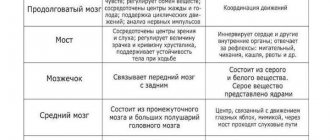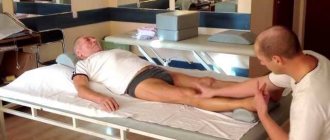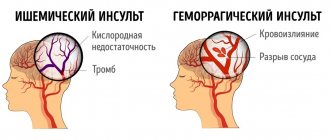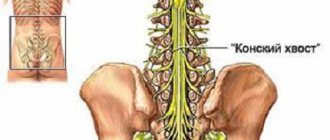Discussion
The high sensitivity of germinomas to radiation and chemotherapy limits the surgery of these deep-seated tumors to obtaining biopsy material and operations aimed at eliminating intracranial hypertension.
With timely diagnosis and early treatment, preoperative symptoms may partially or completely regress. This makes early diagnosis of germinomas important. With the “habitual” localization of the tumor in the pineal and suprasellar region, this, as a rule, does not present any difficulty. Germinomas of the subcortical ganglia are rare, so when the tumor is localized in this area, the histological diagnosis is often unexpected.
Typical manifestations of tumors of the subcortical region, including germinomas, are symptoms of damage to the internal capsule and subcortical nuclei (hemiparesis, extrapyramidal syndrome). In all our observations, hemiparesis of varying severity and extrapyramidal symptoms were detected. Moreover, despite the persistent remission of the disease during treatment, the hemiparesis regressed only partially or did not regress at all. This is due to the infiltrative growth of germinomas, often late diagnosis of the disease and late initiation of therapy. In one of our observations, hemiparesis in the initial stage of the disease was transient, which caused a delay in stereotactic biopsy and a further increase in symptoms.
Diabetes insipidus is often the first and only symptom of the disease in germinomas of the suprasellar region, and in some cases it appears before the tumor is visualized on MRI [11, 12]. In our observations, diabetes insipidus in observation 1 was diagnosed 2 years before the onset of hemiparesis, in observation 2 it developed 8 months after the onset of muscle weakness in the extremities, and in observations 3 and 4 it was absent. The presence of diabetes insipidus and loss of other pituitary functions in the first two cases suggested germinoma, despite the uncharacteristic location of the tumor.
The literature describes cases of disease manifestation in the form of pathological hiccups and vomiting without hydrocephalus [10]. The cause of these symptoms is difficult to explain. Perhaps they are caused by hidden dissemination of the tumor into the medulla oblongata.
The disease also often manifests itself as mental disorders [13, 14]. Three of our patients had psychopathological symptoms in the form of disinhibition, foolishness, decreased criticism, and euphoria. This symptomatology is probably due to damage to the nuclei of the thalamus and their connections with the frontal lobes.
According to the literature, germinomas of the subcortical ganglia are distinguished by a variety of MRI manifestations [8, 9, 14, 15]. Ji Hoon Phi et al. Based on 17 observations and literature data, 4 types of MR patterns of growth of germinomas of the subcortical nodes were identified - from small areas of signal change in the projection of the subcortical nodes that do not accumulate contrast agent, which are often interpreted as a non-tumor lesion (stroke, demyelination), to large space-occupying formations with intense accumulation of contrast and pronounced mass effect [10]. Our observations fully confirm these data. There are also cases of multifocal germinoma lesions involving the subcortical ganglia and other areas of the brain [9, 16–18]. Such a case occurred in one of our observations. Bilateral tumor growth may indicate ependymal spread of germinoma to the opposite side, and may help in the differential diagnosis with glial tumors.
Germinomas of the subcortical ganglia are also characterized by atrophic changes in the brain at the site of the lesion, according to MRI data [15, 19, 20]. In this regard, it should be noted that in one of our observations on a series of repeated MRIs of the brain, a dynamic decrease in the volume of formation of the subcortical nodes was noted, followed by a significant increase. The reason for this phenomenon is unclear, since the patient did not receive hormonal therapy, which could help reduce swelling and partial regression of neurological symptoms. We did not find similar observations in the literature.
Due to the variety of neuroradiological manifestations of subcortical ganglion germinomas, a study of tumor metabolism using C11-methionine PET can provide some assistance in differential diagnosis [7, 10, 21, 22].
Surgical treatment for germinomas of the subcortical ganglia is limited to stereotactic biopsy. In two of our observations, direct neurosurgical intervention was performed due to the severe condition of the patients, caused by a pronounced mass effect and occlusion of the cerebrospinal fluid ducts. In observation 3, removal of a tumor node on the right led to the patient’s left-sided hemiparesis worsening, while the hemiparesis on the right significantly regressed during chemotherapy. In observation 4, regression of hemiparesis was noted in the postoperative period.
There are isolated publications concerning long-term results of treatment of basal ganglia germinomas [9, 10].
According to the data presented in them, patient survival is slightly lower than with germinomas located in the midline. Ji Hoon Phi in 2010 in a series of 17 patients reported 66% disease-free survival and 77% overall survival [10]. Y. Sonoda (2008) in a group of 10 patients noted 3 tumor relapses and 1 death [9]. A possible reason for the unfavorable outcome is the late diagnosis of germinomas of the subcortical ganglia, when the disease takes on a disseminated form, spreading throughout the ependyma of the ventricles and subarachnoid spaces of the central nervous system. Also, the cause of relapses may be an incomplete volume of radiation therapy, which in these cases must necessarily cover the entire ventricular system [10, 17, 23, 24].
Speech disorders due to damage to the cortical parts of the brain
The movement of the speech apparatus and the elementary forms of morphological sensations are preserved, but the structure of the speech act as an activity is disrupted.
Aphasia with damage to afferent units
1. Sensory aphasia
Main defect: impaired understanding of speech, impaired phonemic hearing, i.e. ability to distinguish the sound composition of words.
Symptoms: literal (voice - ear - single) and verbal (replacement of words according to meaning) paraphasia. The hint doesn't help. Inability to understand spoken or noisy speech. In addition to primary symptoms, systemic symptoms can be observed, reflecting a violation of the entire system. They manifest themselves in the alienation of the meaning of the word. The patient loses the meaning of what he perceives.
Tertiary disorders are possible: “verbal hash” or “word salad”: - speech is impaired as a result of a lack of understanding of expressive speech. Speech is a set of shortened forms, emotional exclamations, interjections, etc.
Localization: damage to the left temporal region of the brain.
2. Acoustic-mnestic aphasia
The main defect: impaired auditory-verbal memory - the inability to reproduce a series of sounds and words perceived by ear.
Symptoms:
1. Judgment of the object of reproduction.
2. Modal-nonspecific nature of the disorders, which manifests itself in the auditory-speech sphere.
3. Repeated presentations do not improve reproduction. The introduction of semantic organization improves reproduction.
Localization: damage to the middle parts of the left temporal region. - The mechanism is pathologically increased inhibition of traces by interfering pathogens.
Trials: decrease in memory volume.
3. Optical-mnestic aphasia
The main defect: difficulties in remembering the name of an object or object - a violation of the nominative function of speech and the inability to find the desired object by name. (more often an object than an action)
Symptoms: verbal and literal paraphasia.
— Localization: damage to the posterior temporal and parieto-occipital regions of the brain.
-Mechanism - equalization of trace excitability, i.e. different connections of a word emerge in memory with equal probability.
Test: pictures with objects. The hint helps. When demonstrating glasses: glasses, eyes, eyebrows, glands. In speech: an explanation of the function, purpose, situation in which the object is used, but without using the name of the object.
4. Afferent motor aphasia
The main defect: the kinesthetic basis of articulation and word pronunciation is disrupted.
Symptoms:
- replacement of individual articulations, mixing of sounds.
— Mixing sounds that are similar in articulation. (b-p, m-n)
- Dissociation between the utterance of words that are well known and poorly learned.
— Systemic disorders (writing impairment), difficulty writing letters.
— Reading impairment
— Impaired writing of phrases when the tongue is held tight.
Localization: postcentral parts of the left hemisphere of the brain.
Mechanism: loss of the kinesthetic afferent link of the speech system.
Test: writing words with your tongue held tight, pronouncing similar words, etc.
5. Semantic aphasia
The main defect: the breakdown of understanding, a violation of the understanding of logical-grammatical relationships into which various words enter. Violation of quasi-spatial symbols.
Symptoms: impaired understanding:
1. Prepositions - “a circle over a cross” and “a cross on a circle” - are the same thing.
2. Words with the suffixes “tsa”, denoting a container (breadbox...)
3. Comparative relations (a pen is longer than a pencil)
4. Constructions of the genitive case, (such as “father’s brother” when understanding individual words.)
5. Temporary structures (“before breakfast I read the newspaper”)
6. Speech structures expressing spatial relationships. (The sun illuminates the earth or vice versa)
7. Sentences with logical inversions (“Petya hit Kolya.” Who’s a fighter?)
8. Expressions in which logically related words are far apart from each other.
9. Constructions containing a verb of transitive action. (Petya lent money to Kolya. Vasya borrowed money from Misha. Who owes whom?)
Localization: TPO zone.
Test: presentation of complex sentences.
In case of disruption of efferent links:
6. Efferent motor aphasia
The main defect: disruption of the process of transition from one articulome to another.
Symptoms: the patient correctly articulates the first sound of the first syllable, but cannot move on to the next one. Perseveration. Inert speech stereotypes. Voluntary speech suffers to a greater extent, involuntary speech to a lesser extent. Telegraphic style - replacing an extended sentence with a series of nouns in the nominative case.
Localization: lower part of the premotor area.
Test: count 1, 2, 3, 4, 5, - 1, 2, 3, 4, 5. Count 2, 4, 6, 8, - 2, 3, 4, 5.7.
7. Dynamic aphasia
Main defect.
1. difficulties in extracting individual words, especially verbs.
2. Agramatism - a violation of the completeness or redundancy of what the patient says.
3. Echolalia - repetition of the last words of the instruction instead of completing the task. - Localization: posterior parts of the brain - violation of syntagmatic. The anterior parts of the brain are forms associated with the formation of the speech stream.
Test: method of given associations - the patient is asked to name everything red that he knows. He names only the objects that he sees at the moment. If asked to name a group of nouns and then verbs, the patient names only nouns.
conclusions
Germinomas of the subcortical ganglia are a very rare pathology. Based on our experience and publications, subcortical ganglion germinomas are often diagnosed at a late stage, due to atypical clinical symptoms and a variety of neuroimaging manifestations. The manifestation of the disease in boys in the second decade of life can help in diagnosis: bilateral damage to the subcortical nodes according to MRI; neuroendocrine symptoms that occur in some of these patients, despite the absence of MRI signs of damage to the suprasellar region; psychopathological symptoms that are present in these patients and are not pathognomonic for glial tumors of the subcortical ganglia.
There is no conflict of interest.









